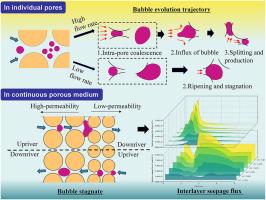Mutual influence of bubble evolution and seepage flow in heterogeneous porous matrices
IF 5.5
0 ENERGY & FUELS
引用次数: 0
Abstract
The seepage characteristics of sediments dynamically alter with the evolution of gas bubbles, significantly affecting the safety and efficiency of engineering processes such as oil and gas extraction, natural gas hydrate exploitation, and geological carbon dioxide sequestration. Based on the phase-field approach, pore-scale models simulate the gas bubble interface evolution and its influence on pore-water flow in individual pores and continuous porous medium. Simulations show that the average velocity peaks of single pore can be observed during bubble influx and splitting, or when the bubble head plugs the pore channel. As the upstream velocity decreases, bubble evolution trajectory shifts from the path of intra-pore coalescence, extra-pore bubble influx, coalescence, and (splitting) production to the path of intra-pore coalescence, inter-pore ripening, and retention. Residual bubbles in continuous media pores reduce permeability by 98.7 %–99.9 %. Bubbles tend to stagnate at high-to-low permeability medium junctions due to inadequate upstream pressure. Conversely, bubbles retain within high-permeability medium's pores during the low-to-high permeability medium flow. Furthermore, interlayer seepage flux of gas and water increases significantly during bubble interporosity flow. Higher upstream pressure shortens the time for bubble evolution, maturation, and interlayer seepage, accelerating the stabilization of the flow field. In summary, the research results reveal the bubble evolution trajectories and seepage characteristic during interporosity flow of heterogeneous reservoirs.

非均质多孔基质中气泡演化与渗流的相互影响
沉积物的渗流特征随着气泡的演化而发生动态变化,对油气开采、天然气水合物开采、地质二氧化碳封存等工程过程的安全性和效率产生重大影响。基于相场方法,孔隙尺度模型模拟了单个孔隙和连续多孔介质中气泡界面演化及其对孔隙-水流动的影响。模拟结果表明,在气泡涌入和分裂以及气泡头堵塞孔道时,可以观察到单孔平均速度峰值。随着上游速度的减小,气泡演化轨迹由孔内聚结、孔外气泡涌入、聚结、(分裂)产生的路径向孔内聚结、孔间成熟和保留的路径转变。连续介质孔隙中残留气泡使渗透率降低98.7% ~ 99.9%。由于上游压力不足,气泡在高-低渗透介质连接处趋于停滞。相反,在低至高渗透介质流动过程中,气泡保留在高渗透介质的孔隙中。气泡渗流过程中,气、水的层间渗流通量显著增大。较高的上游压力缩短了气泡演化、成熟和层间渗流的时间,加速了流场的稳定。综上所述,研究结果揭示了非均质储层孔隙渗流过程中气泡演化轨迹及渗流特征。
本文章由计算机程序翻译,如有差异,请以英文原文为准。
求助全文
约1分钟内获得全文
求助全文

 求助内容:
求助内容: 应助结果提醒方式:
应助结果提醒方式:


